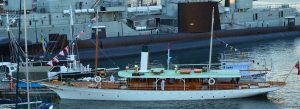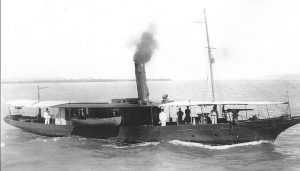- Author
- A.N. Other
- Subjects
- History - general, Ship histories and stories, History - WW1
- Tags
-
- RAN Ships
- HMAS Tingira, HMAS Sleuth
- Publication
- March 2015 edition of the Naval Historical Review (all rights reserved)
This article first appeared in the World Wide Ship Society Victoria Branch July 2014 newsletter and is reproduced with their kind permission and that of the author who is also one of our members. Some excellent coloured photographs of this amazing vessel taken by the author are to be found on the back cover of this magazine.
By Alf Batchelder
Her owner proudly claims that the Steam Yacht Ena is ‘the best boat in Australia’ – and it is hard to disagree, for there are very few vessels like her anywhere. With her clipper bow, counter stern and raked funnel, the white 100-foot vessel is an eye-catcher that will, hopefully, become a familiar sight around Port Phillip Bay.

Ena was constructed in 1900 for Thomas Dibbs, a Sydney banker and Commodore of the Royal Sydney Yacht Squadron, who wanted to watch sailing events and entertain guests in grand style aboard ‘the most elegant steam yacht in the colony’. Designed by the talented Walter Reeks and built by Watty Ford of Berry’s Bay, the vessel was named after Dibbs’s wife Tryphena. While construction was underway, another Sydney yard was cutting down the former HMVS Nelson, which, with 126 guns, had once been the Royal Navy’s largest first rate ship of the line. Some of her timbers were used for Ena’s interior fittings. Consequently, Dibbs could boast that his yacht contained oak that had ‘been seasoning nearly 100 years.’
After Ena was launched, the Australian Town and Country Journal noted her features:On deck she will be fitted with elegant circular top skylights, with embossed glass. There is a deckhouse amidships, combining funnel casing, steering platform, stokehole entrance, galley, and engine-room, so arranged that while giving ample room for their respective purposes, ample promenade space remains. Forward is a steam capstan, of the very latest design, and the steering gear is similar to that fitted in Her Majesty’s Yacht. The latter has been specially imported. Below are two magnificent saloon cabins; the forward, or ladies, saloon, is 18 ft long by the full width of the ship, in which are six berths, with everything arranged with a view to convenience; the after, or gentlemen’s, cabin, is 16 ft long, and has berth accommodation for no fewer than eight persons. Thomas Dibbs was a happy man, for he now owned ‘a boat without equal … larger than those owned by [his] peers and considerably more ornate and plushly furnished.’1
The sixty-ton steam yacht was therefore nothing like a warship. However, midway through World War I, the elegant Ena was offered to the Royal Australian Navy for a modest £1,000. She was turned into an austere patrol craft and, as HMAS Sleuth, her crew of ten were provided with rifles, pistols and a quick-firing Hotchkiss three-pounder, with not more than 48 rounds of ammunition, to convince unarmed merchant vessels around Torres Strait and Thursday Island ‘to heave to and state their business.’2
In 1917, with the German raider Wolf reputedly on the prowl, this was a serious responsibility, but the truth was that, against a hostile adversary, Sleuth would have been hopelessly outclassed. Moreover, with her rapacious appetite for coal, inadequate water capacity and the lack of refrigeration, the grey-hulled Sleuth was never going to be an ideal vessel for service in Australia’s far north. In September 1917, her skipper, Lieutenant James Capstick-Dale, signalled his superiors that his men were refusing to proceed to sea because ‘the ship is totally unsafe’. By that stage, Sleuth had run aground twice, inspiring wits on Thursday Island to remark that she was a fine survey ship because, on almost every voyage, she discovered uncharted rocks and reefs. Eventually, the Naval Board conceded that she was ‘ill-suited’ for duty as an ocean-going patrol vessel.3

On her way back to Sydney, Sleuth again ran aground twice. In December 1917, she was refitted and recommissioned as a tender to the old training ship HMAS Tingira, which was moored at Garden Island. According to one source, ‘her job was to take the lads to sea and show them what being seasick felt like.’4
After her engines failed outside Sydney’s Heads, the navy decided in July 1919 that Sleuth should be sold. Six months later, she was purchased by the Waterside Ship Chandlery and Shipping Company for £1,250. Her new owner, Edward Budrodeen, who wanted ‘something special’ to set off his new Drummoyne mansion, restored Ena to her former glory. Sadly, his marriage collapsed, and his yacht was acquired by the elderly Edward Longworth for his journeys to Port Stephens. When Longworth died in 1928, few could afford to operate Ena as a luxury. She passed into the hands of a Tasmanian syndicate headed by Captain Walter Driscoll, who intended to use her to transport apples from orchards along the Huon and Derwent rivers. It seems an odd plan, as there was little storage space below and stowing cargo on deck made the yacht unstable. On top of that, Ena was put out of business when, during a legal dispute between the syndicate and jam manufacturer Henry Jones and Company, a writ was nailed to her mast. During the inactivity that followed, pieces of equipment were stripped from Ena, and she became badly ‘knocked about’.5
In 1940, Colin, Bill and Max Roche put her to use as a scallop boat. Though their venture was profitable, they fitted a diesel engine in 1945, as they found that her steam engine required too much labour. With her bowsprit removed and her superstructure replaced, Ena was now only a shadow of what she had once been. A new identity therefore seemed appropriate, so she became Aurore, and spent almost three decades with the Roches as a fishing boat, even venturing to Queensland for shark fishing in 1963 and 1964. In 1974, Kevin Hursey used her to gather crayfish before Noel and Geoff Harper decided in 1980 to set her to work in the abalone trade.6
Aurore could well have ended her days on March 4, 1981, when she sank in about sixteen fathoms, being holed, possibly by a floating container, near Margate, south of Hobart. Fortunately, the Harpers bought her back from the underwriters, raised the hulk and eventually sold her to Sydney accountant Pat Burke or, more correctly, to a subsidiary of Hartogen Energy.7
Burke, who decided to revive the name Ena, offered an interest in the multi-million dollar restoration project to the flamboyant Rene Rivkin and his empire. By late 1986, Sydney boatbuilder Nick Masterman had returned Ena ‘to a state rivalling her condition in 1901 when Thomas Dibbs took possession of her.’ During the RAN’s 75th Anniversary Review, Ena provided a remarkable contrast as she passed alongside the massive USS Missouri. (Since she is probably the only Australian ship afloat that can claim service in World War I, she was not totally out of place that day among the warships on Sydney Harbour.) Soon, Ena was off to Fremantle, where guests were entertained on board during the unsuccessful defence of the America’s Cup. In a scene that occurred many times in those days, financial woes led to another writ being nailed to her mast. In 1991, art dealer John Buttsworth acquired her for only $1.2 million ‘on behalf of a private company.’8
As maritime historian Bruce Stannard observed early this year, Ena then became ‘a sleeping beauty, bedded soft in Berry’s Bay, awaiting a reawakening when her canvas covers would be thrown back’ to reveal her elegant lines once more:That day came during the first week of February when the Swiss banker who has owned and maintained the boat for 30 years, ignored bids by some of Australia’s wealthiest individuals and instead chose to sell her to Warwick Turner, a passionate steam enthusiast, based in Echuca, Mr. Turner was one of the founding fathers of the Sydney Heritage Fleet. The anonymous previous owner felt confident that, in the hands of the Turner family, Ena’s steam engine and boilers ‘would not be ripped out and replaced by a modern diesel engine.’9
After a memorable farewell cruise for SHF members on May 30, 2014, Ena left Sydney two days later for her new home in Melbourne’s Docklands. The Turners realise that they have a challenge on their hands, ‘a balancing act in which we will be juggling conservation and commerce.’ May they enjoy every success in their ambitious venture.
Sources:
- The Australian Town and Country Journal, December 22, 1900, p.51; Deans, Alan: Ena, Balmain, 1994, pp.20-22.
- Deans, Alan: op.cit., pp.11-12.
- Deans, Alan: op.cit., pp.24-27; Andrews, Graeme: ‘The long, long story of Ena-Sleuth-Aurore-Ena’, Afloat, July 2012.
- Andrews, Graeme: op.cit.
- Deans, Alan: op.cit., pp.36-39.
- ibid., pp.39-45.
- ibid., pp.39-45; pp.49-63.
- ibid., pp.55-84.
- Stannard, Bruce: ‘Sydney’s iconic steam yacht sails for Melbourne’, Afloat, March 2014, p.37




